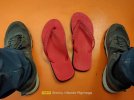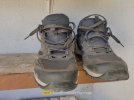- Time of past OR future Camino
- 2017, 2018, 2019, 2025
Longevity of Trail and Street Running Shoes vs Boots
Trail and street runners absolutely will not last for as long as a boot or a heavier hiking shoe. When lighter weight and cushioning for the feet are the primary focus of the user, the materials used are more friable than those used on heavier footwear; materials science has not reached a point where durability AND lightweight cushioning coexist. Maybe someday. Keep in mind that the actual reasons for choosing a trail or road running shoe is what makes their overall lifespan shorter.
I used 5 pairs of trail runners on my thru-hike of the 2,650 mile long Pacific Crest Trail. I bought 6 pairs ahead of time and mailed one pair to a resupply point at defined intervals. Only one pair was truly trash-worthy when replaced; the other 4 pair had some good life left to them. I did not have the luxury of waiting for the BEST and optimal time for replacement of shoes as the hike proceeded, so I had to be exceedingly conservative on determining the margin for usability before replacement.
Why would I choose that type of footwear? My preference was for a shoe with significantly lighter weight, lessened drain on energy levels caused by lifting the weight on my feet - step after step - for 24 to 26-miles each day, lessened risk for injury (fatigued ankle and lower leg muscles and supporting structures are more prone to injury), and the extra comfort provided by the cushioning.
Those are my reasons. While these same reasons are shared by many backpacking enthusiasts in the US (I do not know about the rest of the world) others may prefer heavier footwear including more traditional hiking boots. I used to be in that camp at one time early in my backpacking and climbing career, too.
I do not let longevity of footwear determine what I wear. I focus on comfort of the footwear's fit and feel, and what the overall energy expenditure will be in using them. Then I consider what the conditions are expected to be like (cold, snow, ice). From there, I make my decision.
Trail and street runners absolutely will not last for as long as a boot or a heavier hiking shoe. When lighter weight and cushioning for the feet are the primary focus of the user, the materials used are more friable than those used on heavier footwear; materials science has not reached a point where durability AND lightweight cushioning coexist. Maybe someday. Keep in mind that the actual reasons for choosing a trail or road running shoe is what makes their overall lifespan shorter.
I used 5 pairs of trail runners on my thru-hike of the 2,650 mile long Pacific Crest Trail. I bought 6 pairs ahead of time and mailed one pair to a resupply point at defined intervals. Only one pair was truly trash-worthy when replaced; the other 4 pair had some good life left to them. I did not have the luxury of waiting for the BEST and optimal time for replacement of shoes as the hike proceeded, so I had to be exceedingly conservative on determining the margin for usability before replacement.
Why would I choose that type of footwear? My preference was for a shoe with significantly lighter weight, lessened drain on energy levels caused by lifting the weight on my feet - step after step - for 24 to 26-miles each day, lessened risk for injury (fatigued ankle and lower leg muscles and supporting structures are more prone to injury), and the extra comfort provided by the cushioning.
Those are my reasons. While these same reasons are shared by many backpacking enthusiasts in the US (I do not know about the rest of the world) others may prefer heavier footwear including more traditional hiking boots. I used to be in that camp at one time early in my backpacking and climbing career, too.
I do not let longevity of footwear determine what I wear. I focus on comfort of the footwear's fit and feel, and what the overall energy expenditure will be in using them. Then I consider what the conditions are expected to be like (cold, snow, ice). From there, I make my decision.



























